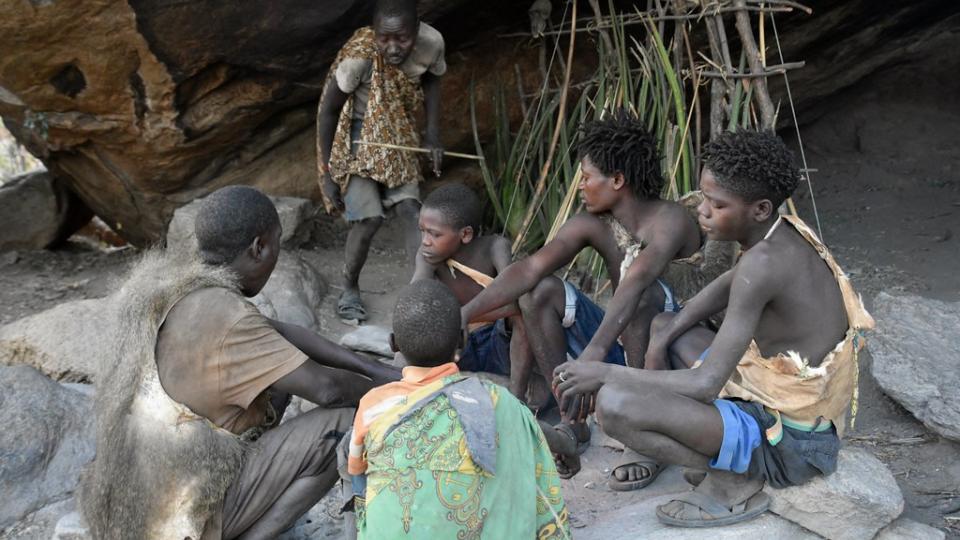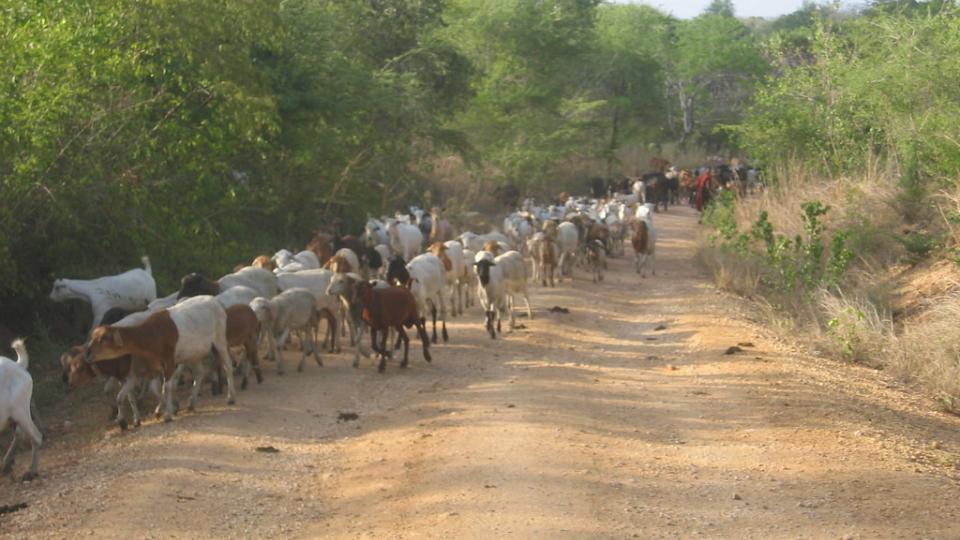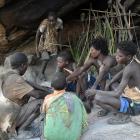
A group of Hadzabe men resting under a rock formation. Most Hadzabe wear contemporary woven clothing but some also wear hide garments.
A group of Hadzabe men resting under a rock formation. Most Hadzabe wear contemporary woven clothing but some also wear hide garments.
Photograph by Richard Mortel, 2016.
Accessed via Flickr on 11 May 2022. Click here to view source.
 This work is licensed under a Creative Commons Attribution 2.0 Generic License.
This work is licensed under a Creative Commons Attribution 2.0 Generic License.
Within the Great Rift Valley in northern Tanzania lies the Eyasi Basin, a savannah of golden dirt speckled with brush, tree, and grass. For thousands of years, it has been inhabited by the Hadzabe, a seminomadic hunter-gatherer culture known for their egalitarian values. As in all ecozones there are limited resources, and the Hadzabe avoid over-hunting or foraging any one area by periodically moving their camps. Even though many groups of Hadzabe reside on this land, the land is shared, as no one ever stays in one place to claim it as their own. Often there is land traditionally utilized by Hadzabe which remains uninhabited for extended periods of time until a group of Hadzabe resettles there. This results in the presumption by outsiders that the land is available for taking. Because of Tanzania’s agricultural boom and discrimination against hunter-gatherers, these unoccupied lots have become a point of conflict that poses grave danger to the lifestyle of the Hadzabe. Loose definitions of who has the rights to land have enabled outside groups to use Hadzabe resources and destroy their way of life.
Pastoralists, particularly Datoga and Masaai, pose a recent, ongoing, threat to traditional Hadzabe land. It is important to recognize that the Datoga have inhabited this region of Tanzania for thousands of years too and face many of the same challenges as the Hadzabe. Land disputes have occurred on the borders of Datoga and Hadzabe land in the past but with this recognition in mind, the growing herds of Datoga cattle and past favoring of agro-pastoralists (non-nomadic people who graze cattle in pastures) over hunter-gathering in the eyes of bureaucrats has pushed land disputes in favor of Datoga in recent years. For food, the Hadzabe rely heavily on large game that graze the grassland and drink from watering holes spread throughout the basin. Pastoralists who allow their animals to over-graze that grassland drive large game away. Additionally, they water their animals at the same watering holes that the Hadzabe hunt and gather at.

A Baobab tree in the dry savanna near the primary water source of the Eyasi Basin, Lake Eyasi. Baobab trees are extraordinary at storing water to survive the dry season, and are common in the dry area of Tanzania where the Hadzabe live.
A Baobab tree in the dry savanna near the primary water source of the Eyasi Basin, Lake Eyasi. Baobab trees are extraordinary at storing water to survive the dry season, and are common in the dry area of Tanzania where the Hadzabe live.
Photograph by Richard Mortel, 2016.
Accessed via Flickr on 11 May 2022. Click here to view source.
 This work is licensed under a Creative Commons Attribution 2.0 Generic License.
This work is licensed under a Creative Commons Attribution 2.0 Generic License.
Other groups that pose a major threat include mining companies, tourists, and commercial hunting groups. In an already water scarce area, over-irrigation of fields and pollution of drinking water by mines and agro-chemicals is detrimental to the Hadzabe way of life. Land clearing is driving away large and small game by destroying their habitat. Commercial hunting particularly in the Serengeti National Park, Ngorongoro National Park, and the Massawa Game Reserve is directly stealing large game that the Hadzabe need to live. The Hadzabe have long been the subject of significant scientific interest, but they have little say in who gets to study their lifestyle scientifically and how. Many Hadzabe are frustrated with the number of invasive samples such as urine and fecal matter taken from them. In 2018 a Hadzabe woman told Alyssa Crittenden of the University of Nevada, “I’m tired giving my hair, my poop, my spit, my urine” (Gibbons 2018).
Within Tanzania, both hunter-gatherer groups and pastoralists are seen as unproductive members of society; this is facilitated by pro-agriculture attitudes within the government. To incentivize agriculture and solve the land rights problem the Tanzanian government implemented a villagization program in the early 1970s. Though the program ended in the 1980s it had a lasting negative impact on the Hadzabe’s position in society. The Hadzabe have, in many cases, been excluded from the political discourse in Tanzania. This is a result of the Hadzabe’s lack of formal leadership and general government discrimination against hunter-gatherers. John R. Campbell goes so far as calling the villagization program a form of “domestic genocide.” The Tanzanian government justified villagization in part by citing land disputes and the importance of “protecting” the Hadzabe culture. It is clear that discrimination and agriculturalist attitudes were the primary motivation for the resettlement program. In 2011 a positive step forward was made: with the help of The Nature Conservancy, the Hadzabe secured a Certificate of Customary Right of Occupancy of 57,000 acres which is recognized by the Tanzanian government.

Maasai pastoralist herding cattle on a dirt road in the savanna. Many herds of around this size out-compete the native fauna of the Eyasi basin for food and water, leaving less game for the Hadzabe to hunt.
Maasai pastoralist herding cattle on a dirt road in the savanna. Many herds of around this size out-compete the native fauna of the Eyasi basin for food and water, leaving less game for the Hadzabe to hunt.
Photograph by Dom Pates, 2021.
Accessed via Flickr on 11 May 2022. Click here to view source.
 This work is licensed under a Creative Commons Attribution 2.0 Generic License.
This work is licensed under a Creative Commons Attribution 2.0 Generic License.
There are few hunter-gatherers left in the world. The Hadzabe are often studied by scientists to help us understand how humans of the past lived; this has been the primary justification for the protection of their rights. It is wrong to use their traditional lifestyle as a justification for protecting their land. Hadzabe are modern human beings living in 2021, and if it were not for environmental destruction at the hands of outsiders, they would be able to sustain their lifestyle for likely thousands more years. Using their history as justification for action only entrenches ideas of hunter-gatherer inferiority in a country where it is a major problem. We should see and protect their lifestyle as valid, sustainable, and admirable, not just as historically, sociologically, and biologically interesting. Action towards reversing the damage done to the Hadzabe should be seen as a defense of human rights, not as the protection of a historical landmark or an endangered species.
How to cite
Jones, Seth. “Threats to the Hadzabe and Why We Should Care.” Environment & Society Portal, Arcadia (Spring 2022), no. 8. Rachel Carson Center for Environment and Society. doi:10.5282/rcc/9413.
ISSN 2199-3408
Environment & Society Portal, Arcadia
 This work is licensed under a Creative Commons Attribution 4.0 International License.
This work is licensed under a Creative Commons Attribution 4.0 International License.
2022 Seth Jones
This refers only to the text and does not include any image rights.
Please click on the images to view their individual rights status.
- Armitage, Derek R. “Environmental Management and Policy in a Dryland Ecozone: The Eyasi-Yaeda Basin, Tanzania.” Ambio 25, no. 6 (1996): 396–402. http://www.jstor.org/stable/4314503.
- Campbell, John R. “Ethnic Minorities and Development: A Prospective Look at the Situation of African Pastoralists and Hunter-Gatherers.” Ethnicities 4, no. 1 (2004): 5–26.
- Gibbons, Ann. “Hadza On the Brink.” Science Magazine, 18 May 2018. (Link)
- Mabulla, Audax Z. “Hunting and Foraging in the Eyasi Basin, Northern Tanzania: Past, Present and Future Prospects.” African Archaeological Review 24, no. 1–2 (2007): 15–33. doi:10.1007/s10437-007-9013-x.
- Maina Peter, Chris. “Human Rights of Indigenous Minorities in Tanzania and the Courts of Law.” International Journal on Minority and Group Rights 14, no. 4 (2007): 455–87. doi:10.1163/138548707x247428.








